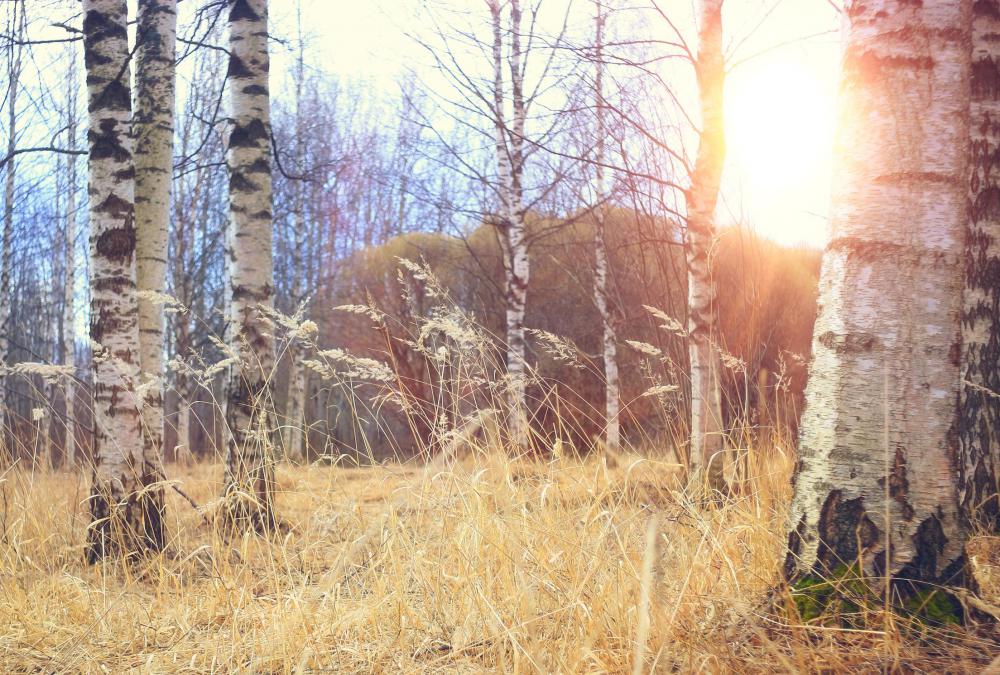At AllThingsNature, we're committed to delivering accurate, trustworthy information. Our expert-authored content is rigorously fact-checked and sourced from credible authorities. Discover how we uphold the highest standards in providing you with reliable knowledge.
What are Birches?
Birches are trees in the genus Betula, native to the Northern Hemisphere. There are around 40 birch species around the world, most of which are found in lowlands such as river valleys. These trees have a number of economic uses, ranging from materials for cabinetry to food ingredients, and birches are also used in landscaping in some regions of the world.
All of the birches look more or less the same, with the key physical difference between birches being the color of their bark and their growth habits. The tallest trees can reach heights of 70 feet (21 meters), and some species known as “weeping birches” grow long branches which bend downwards with age. The leaves of birch trees are simple and serrated, and the bark is very flaky and papery. Some well-known birch species include: red birches, white birches, silver birches, black birches, and yellow birches, all named for the color of their bark.

The bark of birch trees is in fact so paper-like that some cultures have used it for paper. Raw birch bark can be easily and gently removed from trees without damaging them and used for paper, and the bark and wood can also be pulped for the purpose of papermaking. Most birches also have very strong, lightweight wood with a fine grain which is appealing to people in the construction industry, and birchwood is particularly prized for instruments and speakers, thanks to its resonance.
These trees are deciduous, losing their trees in the winter, and they prefer loamy, slightly acidic soil near riverbanks. Birches can thrive in environments where other plants struggle to survive, and they have a tendency to take over if allowed free rein. As long as the trees get enough sunshine and water, they will develop into strong, healthy specimens.
Birch bark has historically been used in teas and tisanes, and birth sap can be brewed into a type of beer. Oil extracted from birches can be used to condition a wide variety of woods, along with leather, and fermented birch leaves were once used to condition sailing equipment in Northern Europe. Several birch species have been bred to create ornamental cultivars with particularly interesting bark or foliage for gardening, and these cultivars are sometimes available through nurseries and garden stores.
Frequently Asked Questions
What exactly are birches?
Birches are deciduous hardwood trees belonging to the genus Betula, characterized by their thin peeling bark and delicate leaves. They are commonly found in temperate and boreal climates across the Northern Hemisphere. Birches are known for their resilience and ability to thrive in poor soils, making them pioneer species in ecological succession.
How can you identify a birch tree?
Birch trees are easily identifiable by their distinctive bark, which can be white, silver, yellow, or black and often peels in paper-like layers. Their leaves are typically small and ovate with a serrated edge. In the spring, birches produce catkins, which are long, cylindrical flower clusters that add to their unique appearance.
What are the common uses for birch wood?
Birch wood is prized for its fine grain and high density, making it ideal for furniture, flooring, and plywood. It's also used in the production of musical instruments due to its excellent acoustic properties. Additionally, birch sap is harvested for making syrup, similar to maple, and has traditional medicinal uses.
Are birch trees beneficial to the environment?
Yes, birch trees play a significant ecological role. They act as pioneer species, often being the first to colonize disturbed or damaged ecosystems, thus paving the way for other species to follow. Their leaves provide food for various insects and caterpillars, which in turn support birds and other wildlife, enhancing biodiversity.
How long do birch trees typically live?
The lifespan of birch trees varies by species, but most live between 40 to 50 years. Some species, like the Yellow Birch, can live longer, up to 150 years. Birches grow quickly but tend to have shorter lifespans compared to other hardwoods, partly due to their susceptibility to pests and diseases.
What challenges do birch trees face?
Birch trees are susceptible to a number of pests and diseases, such as the bronze birch borer and birch leafminer. Climate change also poses a threat, as birches are sensitive to temperature changes and drought conditions. Conservation efforts are important to maintain healthy birch populations and the ecosystems they support.
AS FEATURED ON:
AS FEATURED ON:











Discuss this Article
Post your comments